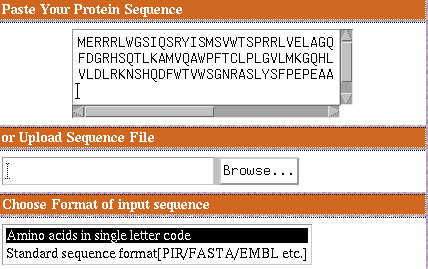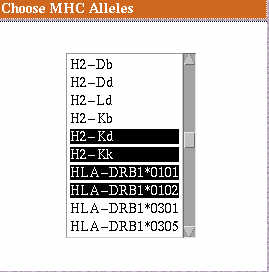|
| Contents |
|
| Introduction | The server allows the prediction of potential MHC class I and MHC class II binding regions from antigenic sequences.The server can predict MHC binding regions or peptides for 97 MHC alleles.The server uses the matrix data in linear fashion for prediction. |
| Stepwise Help | Enter the protein sequence for running prediction.The sequence can be loaded in the provided text box by cutting or pasting. The user can also upload the sequence file through browsing.Then select the format of sequence. The server accept both the formatted and unformatted sequence.The formatted sequence are accepted in almost every standard format like EMBL,PIR,etc.The server uses the ReadSeq program for reading the input sequences.
 Note: All the gaps, non standard characters except the standard protein sequence are ignored from the sequence. The sequence is accepted only in the single amino acid code.
Note: All the gaps, non standard characters except the standard protein sequence are ignored from the sequence. The sequence is accepted only in the single amino acid code.
- Select the MHC molecules for whome user want to run prediction.The user can select multiple MHC alleles by using the ALT or Meta Key.

- The user can alter the search conditions by selecting the value of the threshold.Threshold is defined as the presentage of the Top scoring peptide.for Example the one percent of the threshold will predict the one 1% of best scoring peptides from protein sequence.The lower is the value of threshold more stringent will be prediction results vice versa.
 For getting more detail about threshold Click Here.
For getting more detail about threshold Click Here.
- The server displays results in graphical as well as in text format.The user can select any of display format according his or her requirments.
Each display format has a distinct useful feature.Select one display format.
 The user can limit the number of top scorer peptides to be displayed in case of tabular display format.
The user can limit the number of top scorer peptides to be displayed in case of tabular display format.
|
| Result Display Formats | |
| TmhcPred Matrices | All the matrices for the prediction are obtained from these of servers.
- Propred
- MMBPred
The server uses Addition and Multipication matrices for prediction.
The addition matrices are available for-
All MHC Class II alleles and five MHC Class I alleles HLA-A2.1, HLA-B*0702, HLA-B55, HLA-B*5301 and
HLA-B*5401
The multilication matrices are available for-
All MHC Class I alleles except above mentioned five MHC class I alleles.
|
| TmhcPred Algorithm | The brief description of the algorithm is provided below.The server uses two type of the matrices, Addition and multiplication matrices for prediction.
- The overlapping peptide frames are obtained from the input antigenic sequence. Suppose the length of input sequence is x. Then n numbers of peptide frames each consisting of nine amino acids are obtained by using this formula.
n= (x- length of each peptide frame) +1 ..I
The following overlapping peptide frames obtained from "MERRRLWGIQS" sequence.
MERRRLWGIQS Sequence
MERRRLWGI FrameI
ERRRLWGIQnbsp; FrameII
RRRLWGIQSnbsp; FrameIII
- The initial score for each peptide frame is set at 0.000.
The coefficient value is assigned to each amino acid of peptide frame depending on the type of amino acid and its position in nonamer peptide from the selected matrix.The coefficient values are precalculated and stored in the tables of 20 X 9 known as quantitative matrices.The peptide score is obtained by the summation of each coefficient value. Any peptide having the score more than the selected threshold is known as predicted binder.
Calculation of Score by using multiplication matrices:
- The initial score for each peptide is set at 1.000.
The coefficient value is assigned to each amino acid depending on the type of amino acid and its position in nonamer peptide from the selected matrix.
score= initial score * coeffiecient value for each amino acid.
Final score = Score * final constant
The final constant is a also stored at the bottom of each matrix.
Peptide score = log (Final score).
- The peptide having score more than logrithmic cut score at selected threshold are considered as predicted binders.
|